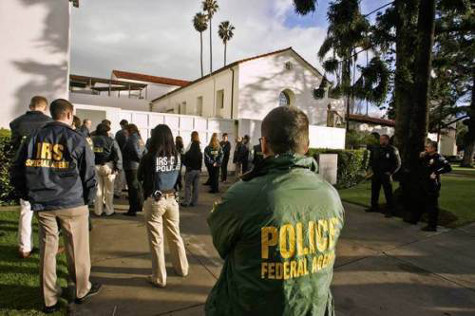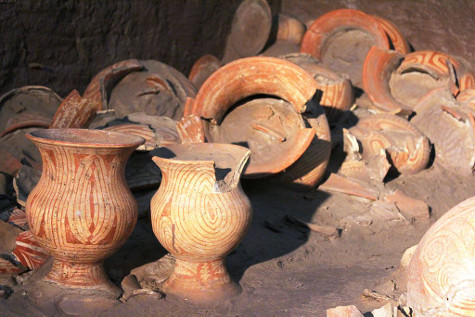
A crowd gathered outside the Bowers Museum in Santa Ana, California, on the morning of January 24, 2008. They weren’t museum junkies; they were federal agents raiding the place. By the end of the day, 500 FBI, IRS, and Customs agents had hit the Bowers and 12 other targets, including the Los Angeles County Museum of Art, San Diego’s Mingei International Museum, the Pacific Asia Museum in Pasadena, the Silk Roads Design Gallery in Los Angeles, and Barry MacLean, a private collector in Chicago. In all, agents seized over 10,000 smuggled antiquities from Thailand, Cambodia, Burma, and China.
Rewind to the late 1970s.
Robert Olson, a former steel salesman, went to a friend’s wedding in Thailand. There, he bought some antique pottery from Ban Chiang, a Neolithic settlement in the country’s far northeast.
When he returned to Los Angeles, Olson decided to sell his 73-piece Native America ladle collection. He contacted Armand Labbé, the Bowers Museum’s chief curator, in 1979. Olson says Labbé offered to take half the ladles as a donation and would arrange for someone to buy the other half for $10,000. And, by the way, those Thai pots are nice—can you get more?
Olson could but not legally. Ban Chiang was continuously occupied from 1500 B.C. to 200 A.D. UNESCO, which named it a World Heritage Site in 1992, calls it both “the most important prehistoric settlement so far discovered in Southeast Asia” and “the richest in Southeast Asia in the number and variety of artifacts recovered.” All its artifacts belonged to the government per a 1961 Thai law, while the 1970 UNESCO Convention on the Means of Prohibiting and Preventing the Illicit Import, Export and Transfer of Ownership of Cultural Property (which the U.S. joined in 1983) banned the export of cultural heritage goods without proper permits.
But these things could be massaged. Starting in the early 1980s, Olson made regular trips to Thailand to buy Ban Chiang artifacts in bulk. He’d disguise their origins (often pasting on “Made in Thailand” stickers to make them look new) and smuggle them into the U.S. for sale.
Labbé became both an enthusiastic customer and a promoter. Between January and September 1985, the Bowers hosted “Ban Chiang: Archaeological Treasures of Prehistoric Thailand,” featuring many artifacts Olson had sourced. Labbé also started passing pieces to other museums, such as the Mingei.
Olson’s business boomed after the show. He catered to art and design businesses in Beverly Hills' and L.A.’s design corridors, as well as to private collectors such as Chicago’s MacLean.
Eventually, Olson hooked up with Marc Pettibone, an American living in Thailand who became his in-country agent. Pettibone bought Thai, Khmer, Burmese, and Chinese artifacts from “diggers” or middlemen and greased the palms of Thai cops and customs agents. Each year, he’d send three or four shipping containers of loot to Olson. Each piece got a misleading description on the customs paperwork and was listed at perhaps 25% of the purchase price so U.S. Customs wouldn’t get too interested.
In 1988, Olsen brought in Jonathan and Cari Markell, who owned the Silk Roads Design Gallery. Silk Roads specialized in rare Asian religious and decorative arts. The Markells began selling trafficked artworks to their collectors and to museums.

They also worked up a side business in creating tax write-offs. The Markells or Labbé would find people in need of some tax relief, sell them an artifact at its market price, create an appraisal for far more than the object’s value, then arrange to donate the object to one of a number of museums using the inflated appraisal. The “donations” usually came in under $5000; the IRS would require far more documentation above that limit.
This little money engine kept chugging through the 1990s.
By 2002, however, the Feds had started looking into the explosion of Southeast Asian antiquities in the U.S. Todd Swain, a National Park Service undercover investigator, asked Roxanna Brown, a leading authority in antique Southeast Asia ceramics, for help. She aimed him at Olson, whom she’d run across during her UCLA Ph.D. studies in the ‘90s.
Thus began Operation Antiquity. Swain posed as Tom Hoyt, a tech executive and Asian art collector, and bought antiquities from Olson eight times. The affidavit supporting the 2008 search warrants describes a typical transaction (this one in 2003): Swain-as-Hoyt went with Labbé to Olson’s storage locker in the L.A. suburb of Cerritos. Labbé pointed out which artifacts he wanted donated and told Swain to pay Olson $12,000 in cash for them. In return, Swain got an appraisal for $43,000, and Labbé accepted Swain’s donation into the Bowers’ collection.
Olson also introduced Swain to the Markells. According to his indictment, Jonathan Markell faked up an appraisal right in front of Swain while the agent’s tape recorder whirred away.
Operation Antiquity’s trap slammed shut in January 2008. The Feds eventually indicted Olson, the Markells, and Pettibone on various charges. Roxanna Brown—who’d shopped Olson to Swain and had served as an occasional expert advisor and snitch until 2004—was outed as a co-conspirator, brokering deals with Olson and allowing the Markells to use her signature on bogus appraisals. The Feds arrested her in Seattle in May 2008; five days later, she died in custody from a perforated ulcer.
In December 2015, Jonathan Markell was sentenced to 18 months in prison for customs violations and (along with his wife) put on probation on tax charges. Cancer killed Labbé in April 2005 and Pettibone in July 2016. Olson, now 87, was supposed to finally go on trial in November 2016, though it’s unclear whether he ever did.
The Bowers repatriated 542 artifacts in 2014. The Mingei returned 68 objects in 2015. Neither MacLean nor the Pacific Asia Museum has given up anything yet. The Markells had to send 337 artifacts back to Thailand and pay $12,000 for the privilege. But it’s too late; looting destroyed Ban Chiang as an archaeological site. The 10,000+ artifacts Pettibone, Olson, and the rest sent to California was 175 times more material than what archaeologists excavated during scientific digs in the 1970s..
As usual in these cases, everyone lost. The museums and collectors lost their money and artifacts, the Thais lost the knowledge the artifacts could have provided, and a World Heritage Site doesn’t have much heritage left.
Interested in art crime? Read Lance Charnes's review of Crime and the Art Market by Riah Pryor!
Lance Charnes is an emergency manager and former Air Force intelligence officer. The protagonist of his art-crime novel The Collection has been known to fiddle with customs paperwork and get inflated art appraisals for clients. Lance's Facebook author page features spies, shipwrecks, art crime and archaeology, among other things.
